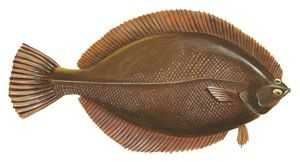Winter Flounder

Species Details
Pseudopleuronectes Americanus
Pleuronectidae
Pleuronectiformes
Continental Shelves, Estuaries
3 - 8 lbs.
9" - 25"
Winter Flounder (Pseudopleuronectes americanus) Description
Also known as the Black Back, the Winter Flounder is a dextral flatfish. Meaning, its eye is more on the right side of its body. Like most flounders, they prefer propelling themselves through the water rather than swimming through. They often swim flat on their bodies instead of the usual upright position. Like all flounders, they have an oval-shaped, thick body.
As their other name describes, the Winter Flounder is known for its jet-black color. However, they are only predominantly jet black. Depending on their habitat, the Winter Flounder can change color from red, olive green, dark green, or dark slate. Like other flounders, Winter Flounders also have a lateral line that cuts across their bodies. They are often mistaken for the Summer Flounder due to their similar appearance. However, the Winter Flounder is known to have smaller teeth and constantly lying on its right side.
Diet and Size
Winter Flounders usually feed on nauplii – the larva stage of crustaceans. But these also feed on invertebrate eggs, some marine bristle worms, and phytoplankton. While these aforementioned preys are a vital part of their diet, adult Winter Flounders are actually not that picky. They’re opportunistic and will eat whatever they can their mouth on. Usually, they find themselves attacking crustaceans such as clams.
Winter Flounders usually grow up to 9.8 inches to 11.8 inches long. However, that’s the usual length for sexual maturity. There are some cases where Winter Flounders grow up to 25 inches. As for weight, the maximum recorded weight of a Winter Flounder is around 8 lbs.
Interesting Facts
- Winter Flounders feed only in the morning. They rely on sight to catch their prey.
- Newly hatched Winter Flounders have eyes at both sides of their head.
- Juvenile Winter Flounders take time to adjust. As they slowly adjust to swimming at the bottom, their eyes slowly move to the right side of their head.
- Winter Flounders can live up to an average of 15-18 years.
- Because of their small mouths, Winter Flounders find themselves limited in the amount they can take in.
- Winter Flounders are common prey to bigger fish such as Striped Bass, Bluefish, Toadfish, and even their own cousin – the Summer Flounder!
- Atlantic Cods, Monkfishes, and Spiny Dogfishes prey on adult Winter Flounders.
- They are sometimes called Lemon Sole in the US.
Fishing Techniques: How to Fish for a Winter Flounder
When fishing for the Winter Flounder, size does matter. The bigger the bait, the better. So, having a big sea worm or a big clam will definitely have those bigger Winter Flounders biting. Although they’re opportunistic, they’re not the type to commit to the kill right away. Like most flounders, the Winter Flounder will definitely take small bites out first. Anglers recommend using a very sensitive rod so you can feel what’s a real tug and what’s just nibbling.
As for line and tackle, it depends. Are you going big or are you going to play safe? If you're going big, the Winter Flounder can weigh around 8 lbs. But some anglers recommend giving a lot of allowance such as getting a 14-20 lbs line to be able to keep a hold on your Winter Flounder. Although the 10-12 lbs line works well, you never know when you might suddenly pull out an extremely large Winter Flounder.
Habitat and Distribution
Winter Flounders stay in estuaries and continental shelves. They hide among the vegetation or rocks while waiting for their prey. As adults, they are quite opportunistic so don’t be surprised if you find one hiding behind the weeds. What makes them hard to find is that their color changes to suit the environment that they’re in so getting them to come out is another story.
As for distribution, they have a preference for the Northwest Atlantic, from the Gulf of St. Lawrence. They also are in bodies of water between Canada and North Carolina. However, most anglers recommend Delaware Bay where they are most abundant.






